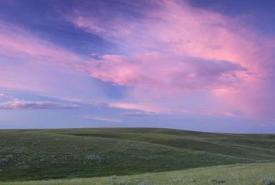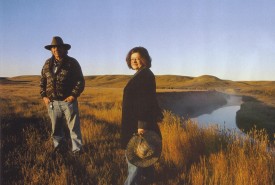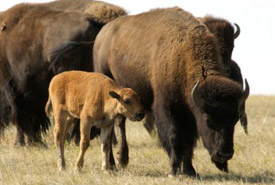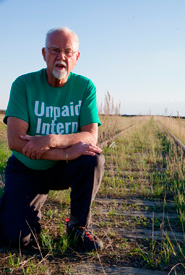Land lines on Old Man on his Back

Evening sky at Old Man on His Back Ranch, SK (Photo by Branimir Gjetvaj)
I was walking with fellow volunteers and Nature Conservancy of Canada (NCC) staff members when someone — I can’t remember who — shouted, “car!” It was an inspired bit of irony, because while my mind was immediately transported back to days of playing road hockey, it certainly seemed out of place on a hot, humid afternoon on the Old Man on his Back Prairie and Heritage Conservation Area, usually shortened to OMB.
The irony is that any vehicle sighting — more likely a half-ton than a car — is an event on this sprawling 13,088-acre (5,297-hectare) NCC property located deep in Saskatchewan’s southwest, near the border with Montana. Over the rest of the weekend, “car!” sightings were a running joke that emphasized the nature of the landscape, a vast expanse of semi-arid, native prairie grassland where you can see a looong way in any direction.

Sharon and Peter Butala at Old Man on His Back, Saskatchewan (Photo by Todd Korol)
One of the chores completed during the Many Ranch Hands Make Light Work Conservation Volunteers weekend in mid-August was sanding and repainting the original home on the property, which calls for a bit of background on how OMB became an NCC property. The area was settled by the Butala family, who raised cattle on their ranch, and cultivated a small portion of the land for feed crops. Some readers will recognize the Butala name through the books of Sharon Butala, who married Peter Butala in 1976, and lived and worked on the ranch. Her book The Perfection of the Morning describes her transition from a career-minded woman living in Saskatoon to the daily and seasonal rhythms of ranch life, what she called her apprenticeship in nature.
And what nature: OMB is part of what is left of one of North America’s major ecosystems, mixed-grass prairie that once spanned parts of three provinces and five states. Most of the prairie was broken for farmland, so OMB is one of the best remaining examples of this ecosystem, providing habitat for various species of plants and animals.
In 1989 Peter and Sharon Butala approached the Nature Conservancy of Canada and Saskatchewan Environment about buying the ranch as a way of conserving the native prairie. The agreement was concluded in 1996, ensuring the OMB property will be protected forever. In 2003 NCC re-introduced a herd of plains bison to the property to maintain and enhance the area’s biodiversity.
One of our activities as volunteers on this particular weekend activities was a summer bison count, and NCC staff took us down a trail so we could watch the herd as they moved from one pasture area to another. I have to admit I was more intent on taking photos than helping to count these magnificent animals. I suspect NCC staff on horseback will come up with a more accurate count than any of us volunteers.

Plains bison (Photo by Karol Dabbs)
NCC is also working to return the cultivated land on the property to its native state, although that was not on the volunteers’ to-do list on this weekend. Volunteers did help with capping a couple of kilometres of hollow steel pipe used as fencing along the roads near the interpretive centre. Experience has shown that small birds could fall into the hollow posts and be trapped there, unable to escape. While we managed to place donated plastic caps on some of the posts, many more kilometres of posts remain to be capped. I expect this chore will be on the to-do list for future volunteer weekends.
Several volunteers, including myself, dug into the thick prairie thatch to create a modest demonstration garden beside the interpretive centre. Several kinds of native plants and grasses were planted in the garden. I expect regular updates on how the garden is progressing. Do I sound like a gardener?
On Saturday, Sue Dumontel, a long-time resident of the area who is contracted by NCC to deliver an interpretive program about OMB, did just that. Sue has a wealth of knowledge about the people and events of the area, and has the knack of weaving captivating stories from her knowledge.
As for how the OMB got its memorable name, Sue explained that it may have been the First Nations people who saw the figure of a man lying on his back in the outline of a nearby plateau who gave it its name. However, she added, while many people have searched for the right vantage point to find the figure of the old man on his back, none of the locals she knows claim to have seen it.
Nevertheless, the Old Man on his Back is firmly embedded in local history. To me, it is one of Canada’s ecological, cultural and historical treasures. Thanks NCC for the chance to be part of this OMB volunteer weekend.


